La
Dolce Vita (re-post from my previous site)
1960
Director: Federico Fellini
Starring: Marcello Mastroianni, Anouk
Aimee, Anita Ekberg, Yvonne Furneaux
La
Dolce Vita
opens with a very famous shot of a helicopter flying a gigantic statue of
Christ over the city of Rome, and the ludicrous nature of this action, in a
way, completely sets the tone for this incredibly famous film. What on earth is going on, you may ask. To which Fellini replies: Exactly.
Marcello
Rubini (Mastroianni) is a gossip columnist who kind of sort of both loves and
hates his life. The movie doesn’t
exactly have a plot; it’s more an exploration of a “day in the life” of this
man. We move from episode to episode,
all the while following Marcello as he is buffeted from one situation to
another. He is not exactly in control of
his fate, and we are along for the ride as life moves him through the film.
Marcello
as the central character is interesting.
He is not a hero, not in the least.
I’m not even sure he’s a good man.
He’s a weak man, a man who talks of being taken seriously then gets
distracted. He has a girlfriend and a
lover and still gets seduced by other women.
He flirts with anything in a skirt, yet he does so because he feels he
has to, not because he wants to. He
speaks of love with such shallow feeling, it’s frightening. Yet for all of this, he is not condoned by
the film. I do not envy his life; I
don’t see how anyone could. He is a man
sick to death of his life – why would you envy that? Yes, his life throws him in the path of
celebrities and beautiful women, but he takes such little enjoyment from it,
it’s downright depressing. Ultimately,
though, Fellini loves his Marcello for all his faults. It’s a fascinating character study,
really. Marcello is not good, but he’s
not evil. He’s not a hero, but he’s far
from a villain. He’s just a man. An ordinary, tired, almost middle-aged man
who wonders what his life has become. If
anything, Marcello is sad. That’s how I
read him at least, and if ever there was a character open to interpretation,
this is it.
There
are moments of tremendous poignancy which, for me, emotionally ground the film
in the middle of all the whacko-nutso behavior.
Two sequences in particular stand out as moments of sad gravity: the
Steiner sequence and the scenes with Marcello’s father. In the first, Marcello meets with his old friend
Steiner. Steiner is everything Marcello
is not: serious, focused, married, a father.
Marcello idolizes Steiner and treats him with reverence. Marcello goes to a dinner party at Steiner’s
apartment, and the people who are there are serious artists – or, at least,
much more serious about art and living than all the vainglorious celebrities
that Marcello reports on. I found myself
thinking, “Ah! At last! We have found the hero of the film! This is the man that will make over
Marcello!” Fellini, knowing all too well
the pedestal that he had seated Steiner upon, knew it would not do to have a
hero, not in this film, and in a shockingly sad and devastating sequence,
reminds us that people like Steiner, as wonderful as they may seem, are only
human too.
In
the second sequence, Marcello’s father, a traveling salesman, comes to visit
unexpectedly. Marcello takes him out on
the town to a cabaret, where they all get drunk and Marcello marvels at his
father’s excesses. Perhaps he was cut
from the same cloth? Marcello’s father
goes home with a cabaret girl but has some sort of an episode, and he winds up
leaving her apartment looking weak and frail.
This, to me, is not the sad part.
The part that sticks in my mind is what immediately follows. Marcello begs his father to stay one more day
in Rome. Begs. Completely begs. And his father says no. This simple exchange, only a minute or two on
screen, is beyond sad. A grown man has
finally realized that he doesn’t know his father but that he WANTS to know his
father, and his father steadfastly refuses.
This little moment of heartbreak and agony in the midst of all the
excess of the rest of the film reminds you that Fellini can do serious just as
well as he can do ridiculous.
How
Fellini chooses to inhabit his world is fascinating. I don’t just mean the main characters, but all
the people who appear on screen. When
watching this film, watch the extras.
Look at them. They are just as
bizarre as the characters with lines.
Look at the woman with the spider rhinestone glasses. Who is she?
No one is incidental in Fellini’s world – even his extras have enormous
stories that they aren’t telling.
I
was struck by the unbelievable shot composition of La Dolce Vita - even in
comparison with other fantastically photographed films. Holy cow, but Fellini has an impeccable
eye. It’s not something I really noticed
the first time I watched it about five years ago. I admit that, in that first viewing, I had no
idea what the eff I was watching. I feel
like I was watching it just to watch it, without really understanding it. I don’t pretend to understand La
Dolce Vita completely after my second viewing, but I feel like I got
more out of it this time around, and I was amazed the shot composition more
this time around. Scene after scene is
breathtaking. I put it right up there
with Sven Nykvist’s work in The Seventh Seal, an absolute
favorite of mine. Fellini clearly loves
black and white, as he uses black and white phenomenally well, not just in the
photography but also the costumes. Some
shots are symmetrical, beautiful in their alignment. Others are point of view – when Marcello runs
up the tower steps, we suddenly see the curved wall through his eyes, and get a
rush of excitement. And Fellini loves
the panorama. His crowd-scapes are
fascinating. I can’t even try to
logically put my feelings into words – you just have to see it for yourself.
One
thing I have recently started to notice about films is the location they
present. I don’t mean, “Hey, look, shot
in London!” Rather, what is the version
of the location that the director is showing us? The New York City shown in, say, Sex and the City is a very different New
York City shown in Midnight Cowboy. So
through the lens of these new glasses, I find it interesting to discover
Fellini’s Rome. For this is, most
definitely, Fellini’s Rome. It is a city
of dirt roads right next to glittering new high rises. There is dust and construction and clutter
all over the place, contrasting with the clean, white lines of sophisticated
buildings, lending the city a constant sense of pandemonium. The city seems to be in the middle of nowhere
– characters drive for two seconds and are then in the country. Fellini’s Rome seems an isolated place to me.
In
many ways, La Dolce Vita is a bit of a tough nut to crack. Made between Nights of Cabiria and 8½,
La
Dolce Vita clearly straddles Fellini’s transition from straightforward,
realistic narrative to off-the-deep-end whimsy and surrealism. There are elements of both in this, the
middle film. It’s a film that demands
repeated viewings; I have a feeling that what I get out of it will change the
more I live my life. As a film, I feel
like I still don’t totally get it, but it’s a heady ride.
Add-on:
Because I’m me and I’m still copying old reviews from my previous site onto
this one (as is the case with La Dolce Vita – this review was
written about a year ago), I seriously wanted to re-evaluate the score I gave
this. Do I really like Fellini THAT
much? No, I thought; I’m not really a
Fellini fan, and he goes to some really weird places in his later films. But then I re-read what I wrote, and I
remembered exactly how excited this movie made me. Just how good the photography is. Just how sad parts of it really get. Just how much it really did touch me, in a
strange Fellini-esque way. I will NOT
let my less than enthusiastic opinion of Fellini in general deter me from
recognizing how much I actually enjoy this film of his.
Arbitrary
rating: 8/10, and in terms of Fellini, one of my favorites. I tend not to enjoy him nearly as much after
he went off the deep end with his later works.
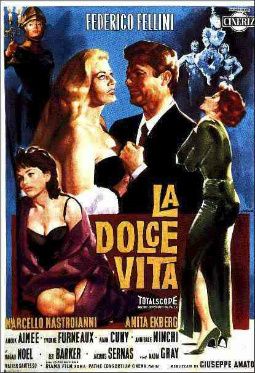
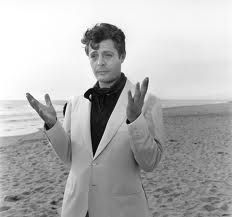
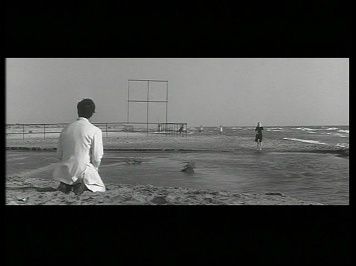
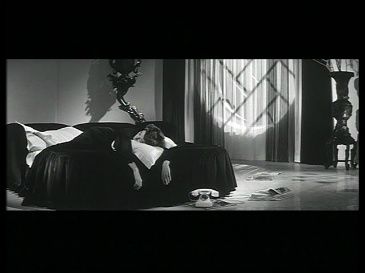
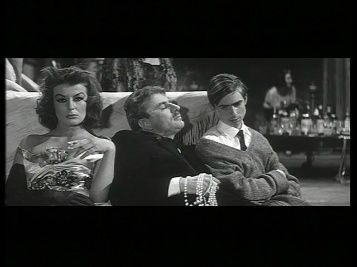
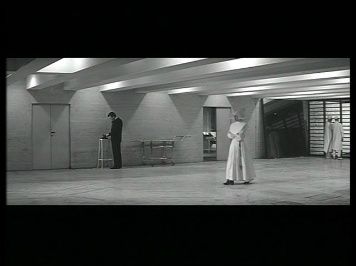
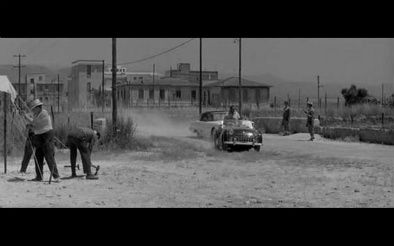
For the most part Fellini's films don't do much for me. The only one I truly felt was very good was Nights of Cabiria. Amarcord was decent. This film I felt was okay. Every other Fellini film I've seen, including his most famous like 8 1/2 and La Strada, either did nothing for me, or I even disliked them.
ReplyDeleteI noted with amusement that Anita Ekberg was not mentioned whatsoever in this review (the female perspective), yet she's about the only character that made a lasting impression on me from when I saw this film 4-5 years ago (the male perspective.) The Marcello character held no interest for me at all, yet he dominated your impressions from the film. Gee, I wonder why the two of us might have had such different memories of this film. :-)
Yeah, the Ekberg episode, although the most famous sequence of the film, did little for me. And because, in retrospect, one of the big purposes of writing about a film is to remember what I saw, I chose to leave it out because EVERYONE knows about the fountain scene. I wanted to remember the OTHER stuff.
DeleteI definitely liked Nights of Cabiria the most. 8 1/2... not so much.